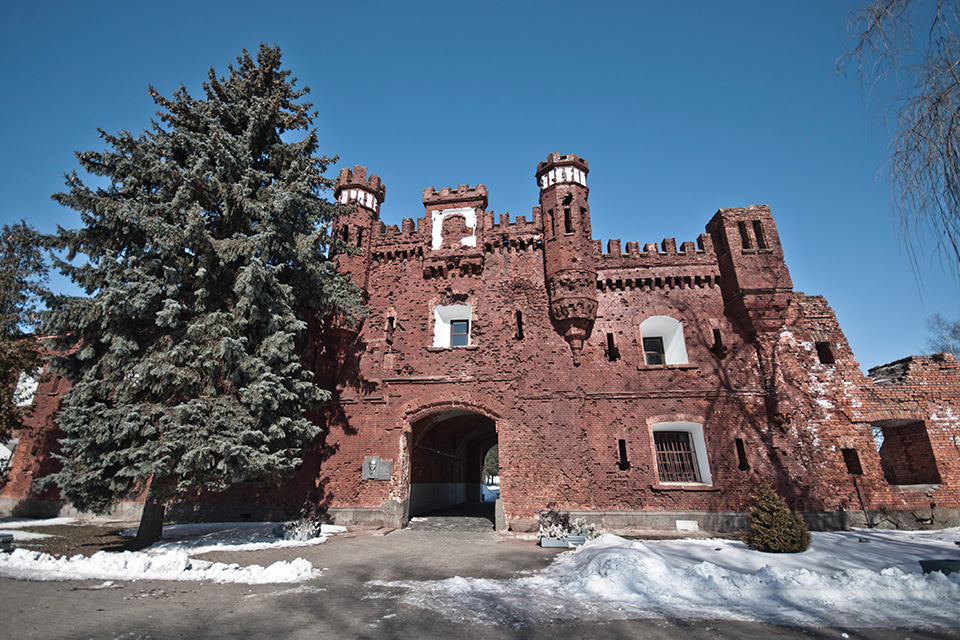The Brest fortress

Монумент «Мужество» © Marco Fieber


Главный монумент – скульптурное изображение воина и знамени © Marco Fieber


Холмские ворота Брестской крепости © Marco Fieber

Brest fortress - the symbol of courage of the Belarusian people
One of the favorite tourists from different corners of our planet places was the memorial complex Brest fortress – hero. "We will die, but the fortress will not go" - almost every Belarusian knows these words. The complex is located on the border of Belarus with Poland, on the outskirts of Brest.
The Brest fortress – world famous memorial, which became a symbol of resistance of the Soviet people during the second world war. Belarusians call memorial one of the seven wonders of the world. About the Brest fortress removed a lot of movies, written many books. In 2010 he released an art film Brest fortress (directed by Alexander Kott), made jointly by Russia and Belarus. The film tells how the Brest fortress was heroically received the attack of the German invaders in 1941. The film describes the three main pockets of resistance, which was headed by regiment commander Pyotr Gavrilov, Commissioner Yefim Fomin and the head of the 9th frontier post, Andrey Kizhevatov. The film received high marks from film critics and the delighted responses of the audience. This is not surprising because at the memorial complex has such a rich history.
The Brest hero-fortress: history
The building appeared on the Islands, which are formed by the rivers Western bug and Mukhavets in the mid-19th century. It was a wooden castle, around which began to grow the city. Berestye – so he calls the settlement "the Tale of bygone years", written by the monk Nestor, in connection with the events of 1019. It is believed that the town's name came from the word "elm" or "elm" (elm).
Brest is a border town, so his story has to do with the attacks, invasions and wars. Many have tried to occupy this strategic point – the Russian squad, Lithuanian knights, the Mongol-Tatar hordes. The city required a good defense, so in the 19th century, Nicholas I ordered to build a powerful fortress that can serve as a great defense against enemies.
Already by 1842 in the city over the bug was built a fortified citadel. During construction, destroyed many ancient buildings of the city (about 500 structures). Archaeologists are unable to accept the loss of the monuments of the ancient city. They have done a remarkable job. Thanks to their efforts, today the Fort operates an archaeological Museum "Berestie", where visitors can see the city before the construction of the citadel (11-13 centuries).
World war II: defense of Brest fortress
Once you get to the memorial, I immediately felt that once in his book "Brest fortress" described by Sergei Smirnov. At 4 am on 22 June the German attack was for the defenders sudden and swift. The fortress held for almost a month. Each brick Holmsky gates recalls a terrible war, about the brutal massacre against the German invaders. The Germans were walking across a bridge, and the defenders defended of the brick barracks. Hitler's troops were originally winning due to the size of the army, large technical opportunities and surprise attacks. But the Belarusian soldiers were courageous and brave, ready to fight to the end. The gate is riddled with shells and bullets.
The fortress had no water. Today, the complex you can see the monument "Thirst", which depicts a soldier with helmet extending over the water. Some weeks the defenders of the fortress suffered from thirst. Around was the river, but to get it was impossible – the Germans were not allowed ashore. Some risked their lives night and waded over the water. They brought water in helmets and bowlers, women and children who were hiding in the basement of the barracks.
In one of the surviving barracks today you can visit the Museum of Brest fortress. Here you can see helmets, hats, banners, old photographs, Union card senior nurse with the names of the dead and wounded, a piece of paper with the Order number 1, the alarm clock that stopped from the first explosion.
From the fortress left in ruins. Among them currently are monuments and memorials. On the walls are the defenders of the inscriptions: "Die, but not get out of here!" "I die but don't surrender. Goodbye, Motherland!", "There were three of us, it was difficult for us, but we did not lose heart and die like heroes"...
What to see in Brest fortress
After the war, the fortress is fully restored. To perpetuate the memory of the heroes here have created a memorial. What to see:
- Area Ceremonies
- The Sculpture "Thirst"
- 3 rows of memorial plates, where the dead are buried
- Ruins
- Museum
- The preserved buildings
- The obelisk "Bayonet", a height of a hundred meters
The main entrance is made in the form of a large star carved into the concrete block. In this place visitors are greeted by a song by A. Alexandrov "Holy war", against which you hear the message of the government of the German attack.
Brest fortress is a 30-minute walk from the centre, so it can be easily reached on foot. From the city every hour in the direction of the memorial complex leaves the bus.


